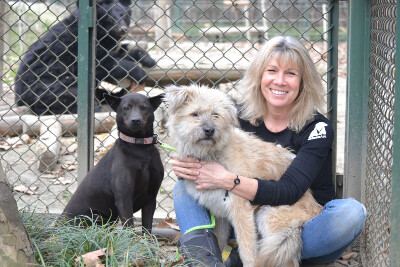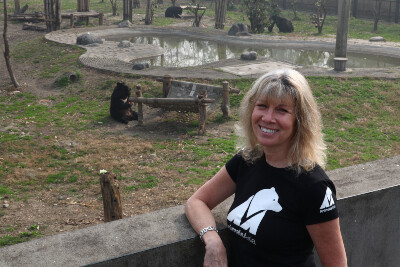

Estimated reading time: 5 minutes
Updated 8 August 2023
When we last spoke to Jill Robinson, Animals Asia was successfully fighting bear bile farming in south east Asia.
That was in 2018, and while a global pandemic might have slowed things down, Jill’s determination is stronger than ever.
We caught up with Jill for an update, and to see how Covid affected the Vietnamese governments’ pledge to phase out bear bile farming by 2022.
The day Jill came face to face with bear bile farming
Jill Robinson pledged to end bear bile farming the moment she stepped foot inside a bile farm.
In 1993, Jill was working for IFAW when a friend told her about a bile farm he had just visited.
So, just a week after learning about the farms’ existence, she travelled to China to see it herself.
Little did she know the horror that would greet her there.


“Never before had I felt so shocked or helpless; sick to my stomach with the reality of what these creatures had suffered.”
The owners met the group outside; both husband and wife boasting about the ailments their bile could cure.
“There was a bear pit inside and the owners were encouraging us to buy apples on strings to tease them with,” recalls Jill.
While the other tourists were distracted with apples and purchasing the bile products, Jill decided to explore the farm further.
What she found hidden out of public view revealed the true horror of the bear bile industry.
Crush cages, open wounds, and scars: the reality for bears on bile farms
“Absolutely nothing prepared me for that moment,” Jill says.
“Thirty-two moon bears stared forlornly out of their crush cages, making nervous popping noises every time I approached them.”
The bears often spend their entire lives in the crush cages; often they’re not much bigger than the bears themselves.
The cages are not much bigger than the bears themselves.
As a result, they are prevented from standing up and, often, even turning around.
“I could see the bears were afraid and were clearly anticipating something bad was about to happen to them.”


On closer inspection, it was clear to Jill why these bears were afraid.
Because the bears had suffered so many years of torment confined in tiny cages, their bodies were covered in scars.
“The scars were three or four feet in length along their bodies, and their teeth were smashed from repeatedly biting the bars in frustration.”
Some of the bears had their teeth pulled out or their paw tips cut off, making them less dangerous to the farmers.
“Worst of all,” Jill says “metal catheters were poking out from infected holes in their abdomens, from where the bile is milked.”
Jill credits the following moment – one she will never forget – for the creation of Animals Asia.
“I felt something touch my shoulder; I turned around to see a bear reaching through the cage,” explains Jill.
“It seemed right to take her paw in mine and rather than hurting me, she squeezed my fingers in desperation.
“While I knew I’d never see her again, that moment saw a promise that bear bile farming would one day end.”
Horror turned to hope when Jill founded Animals Asia
Jill ultimately founded Animals Asia in 1998 which now has sanctuaries in China and Vietnam.
In 2018, Animals Asia had rescued more than 600 bears and were campaigning to close a bear farm in China that housed approximately 100 bears
Jill told us this week that the rescue was successful; though it took longer than planned because of the pandemic.
“Last year was huge for us,” says Jill. “In the space of just a few weeks we moved 101 bears from that farm in Nanning to our Chengdu sanctuary.
The Vietnamese Government supports Jill and Animals Asia’s campaign to end to the bear bile industry in the country.


The Vietnamese government invited Jill to join them in a press conference in 2017 where they pledged an end to the industry by 2022.
Bears kept for bile have already dropped from 4,000 at the industry’s height, to approximately 900 today.
What drives Jill is the ability to heal a rescued bears’ body and mind.q
“We are able to create an example of good management and care for animals who were utterly exploited,” says Jill.
“Our state-of-the-art centres allow the bears to enjoy the most incredible lives of happiness, peace and choice.”
Animal Asia’s ongoing work to end bear bile farms in Asia
Jill credits the bears themselves for helping her avoid burnout, which commonly affects those working in animal welfare.
“We bring the bears freedom from pain and witness the peace and happiness in their new lives, and that’s what allows me to avoid the psychological distress after what I’ve witnessed,” Jill says.
“I’ve come to realise that it’s actually the bears who have rescued me.”
Jill says she’s an eternal optimist and this only increases as she gets older and witnesses the change and difference their work, projects and rescue centres have created.
“Someone said that our sanctuaries are ‘food for the soul’ and there’s absolutely no doubt they are,” says Jill.
“It’s impossible not to remain positive after seeing the progress made.
“The compassion in people’s hearts is extremely inspiring.”
Visit the Animals Asia website to learn more about the organisation and the fight for bears.
